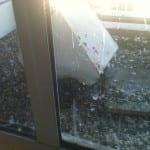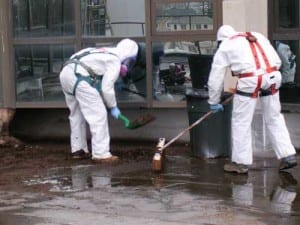Pigeon feces may contain bacteria and other pathogens that can cause illness. Prevent infection by avoiding direct contact with bird debris while cleaning affected areas. Keep children and pets away from areas which have accumulated bird debris.
Wear personal protection equipment (PPE) when cleaning up fecal matter
Follow these steps to clean and sanitize properly:
- Prepare a 10 percent solution of sodium hypochlorite by mixing one part bleach with nine parts water.
- If indoors, mist the area to settle suspended air-borne particles.
- Soak the area with the bleach solution and leave it undisturbed for at least 10 minutes. This will disinfect and soften the droppings, making them easy to remove.
- apply and spread the bleach solution.
- Re-wet the area with the bleach solution if the area starts to dry during the 10 minute soak.
- Dense accumulations of feces may require repeated applications of the bleach solution.
- Place the debris into a doubled plastic bag (a plastic bag in another plastic bag).
- Use a square-nosed shovel or a hoe to scrape up the debris.
- Seal both bags.
- Place bags in the outside trash.
- Using dish soap or laundry detergent, scrub the area with a stiff brush or broom to remove debris from cracks and crevices. Rinse area with water.
- A power washer can be used for this step.
- Reapply the bleach solution and keep the area wet for another 10 minutes. Do not rinse.
- If the treated area receives at least 4 hours of direct sun, this step can be omitted as ultraviolet light has disinfecting properties.
- Air-dry before allowing people and pets into the area.
This procedure may not remove all stains and the use of bleach may discolor walkways, sides of building, and other structures and may cause damage to growing vegetation. Damage may be prevented by using a commercial disinfectant without sodium hypochlorite. Read label instructions before using these products.
If a sensitive area receives a considerable amount of sunlight, the disinfectant may not be necessary as the sun’s UV light works as a natural disinfectant. Physical removal of the debris is necessary. This method is also considered acceptable for areas with little or no foot traffic.
Keep children and pets away from contaminated areas until they have been cleaned, sanitized and dried.
- If pigeon debris is in an enclosed area, such as an attic, open windows and use fans to force fresh air into the area before cleaning.
- Leave area undisturbed to prevent air-borne particles.
- Never handle a dead bird with your bare hands.
- Use rubber gloves or an inverted plastic bag to pick up the bird.
- Place the dead bird into a plastic bag, seal bag and place in an outdoor, covered trash container.
- Clothes worn during cleaning should be washed separately in hot water. If possible use a disinfectant in the wash.
About Pigeon Patrol:
Pigeon Patrol Products & Services is the leading manufacturer and distributor of bird deterrent (control) products in Canada. Pigeon Patrol products have solved pest bird problems in industrial, commercial, and residential settings since 2000, by using safe and humane bird deterrents with only bird and animal friendly solutions. At Pigeon Patrol, we manufacture and offer a variety of bird deterrents, ranging from Ultra-flex Bird Spikes with UV protection, Bird Netting, 4-S Gel and the best Ultrasonic and audible sound devices on the market today.
Voted Best Canadian wholesaler for Bird Deterrent products four years in a row. Contact Info: 1- 877– 4– NO-BIRD (www.pigeonpatrol.ca) Now shipping World Wide.



